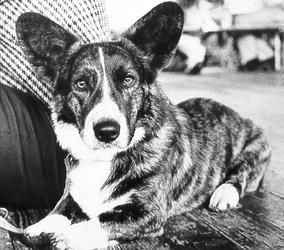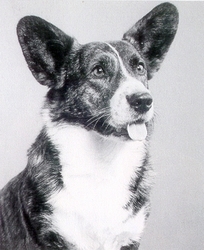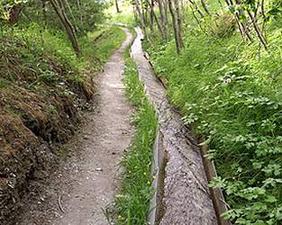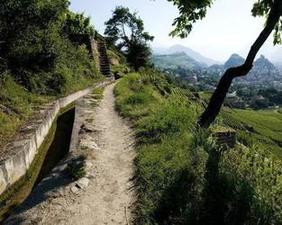|
Ordeal By
Water
By Andrew Bushnell, Switzerland This true story shows again the robust health and character of a Cardigan Corgi who runs mountain marathons in the Alps. However, it has such a nightmarish quality that I tell it in the present tense. 
Swiss & Int. Ch. Cardwyn Gwylon alias Bryn (1985-1996) Being alone at home with my dog Bryn one Sunday, I take him out for a walk while a pizza is heating in the oven. We meet a retired but vigorous old man, the warden who watches over an irrigation channel crossing several kilometres of steep alpine mountain side*. Suddenly realising that Bryn is missing, I call him in all directions. He often paddles in the irrigation channel to refresh himself. But just at this point the water in the ditch was deeper and flows quickly into two kilometres of old concrete pipes buried under the vineyards. Fearing the worst, I run after the warden, asking him to get the water cut off quickly, but he says that is not possible. It would take hours for him to walk to the water source in the roadless gorge, and then the water to subside. He advised me to look at the other end of the pipe where the water emerges after a quarter of an hour in transit. Hurry! Run home, remove pizza from oven, ride motor scooter as far as mountain track allows, climb up beside waterfall. Time for doubts during a long wait where the water re-emerges as an idyllic stream in the woods. Has the water already carried Bryn over the waterfall and killed him on the rocks 10 metres below? No sign of him on the rocks. Perhaps Bryn was never swept into the pipe in the first place, but is waiting where I last saw him? Hurry! Ride back to beginning of pipe, ask a young woman and her grandmother if they have seen Bryn - they are from the village and know him; call Bryn again; still no sign, return home to eat. Just as lunch is ready to serve, the door bell rings. The two women have heard Bryn barking under a heavy manhole cover, but they could not lift it. By the time they had stopped a motorist to help, Bryn was no longer there. The young woman and her husband had then come to fetch me by car. Hurry! Remove pizza from oven, grab rope and torch, drive to irrigation channel, lift manhole cover, look, call and listen. No sign of Bryn. But there are more manhole covers further along the path, and in the hedges, and on overgrown banks, among briars and stinging nettles. The young woman accompanies me out of pity for the dog. I am glad of her moral support along two kilometres and fifty-odd manhole covers, not counting the ones we couldn't find or couldn't open. Then the same ones and more on the way back. Starting for a third time, we have to give up, defeated by tiredness/hunger, dusk and a thunderstorm. At their summer house in the vineyards, the woman's family say there is no hope because the freezing cold glacier water probably fills the 90 cm (3ft) pipe to the top in places. At home that evening, chewing my dried up pizza, I wonder how to tell my wife, and how to tell a dog breeder who plans to bring his bitch for mating. Like Little Albert and the Lion, "Oh no, Bryn isn't lost: we know where he is!" In a downpour and thunderstorm late that evening my wife arrives home from her pilgrimage to Lourdes. With faint hope, we leave the garage door ajar, with food, milk and Bryn's bed on the floor inside. I hand my wife a tube of ointment to rub on my tired back: soon after, my heart begins to race at twice my normal pulse rate: the ointment must have been the wrong kind. I pass an uneasy night, thinking of Bryn clinging to some small foothold in the freezing water, if he is still alive. On Monday morning I request a day's holiday from work so that my wife and I can repeat the search, if only to settle our minds. Lift each manhole cover, look, call, listen, and clang shut, then search for the next cover downstream. Under the fiftieth cover some large floating object had shifted a thin vine stem wedged across the pipe the day before. But after lifting the 56th manhole cover we still see only cold, rushing water, and hear only echoes of our own voices. End of pipeline: end of hope. Back home for lunch, I trip over the dog's toys as usual and decide to tidy them away to the garage. In the garage I find Bryn finishing off his food and drink! Tired, damp, red-eyed with his pads and claws worn down to the quick after 20 hours struggling in the cold water, he had finally escaped and found his own way home.  I like to think that our calls,
successively downstream, made Bryn give up holding on in the
pipe, and let himself be swept out while he still had the
strength to stay afloat and to scramble out of the channel
before the waterfall. I like to think that our calls,
successively downstream, made Bryn give up holding on in the
pipe, and let himself be swept out while he still had the
strength to stay afloat and to scramble out of the channel
before the waterfall.
The vet gave Bryn preventive injections against pneumonia and cramp, and declared him physically sound. But for several days Bryn preferred to observe the world from a balcony as far as possible from the front door. He would walk no more than a few yards from the house, and then only in the opposite direction from the vineyards. Had his ordeal left permanent psychological scars? After a quiet week Bryn was back to normal, and went paddling in the streams and irrigation channels as before. At the entrance to the pipe where he had disappeared, I always keep him under control and scold him, but he just looks at me as if to say, "Mind you don't fall in!" Published in the CWCA Handbook 1999 Reproduced with the kind permission of the author. *) Hill irrigation in the Swiss Alps has a long tradition of more than 700 years, especially in the Rhone Valley (the Canton of Valais) where a network of more than 1400 km of channels was created. Until the 19th century, irrigation was generally limited to the meadows. In the 19th century, it was extended to vineyards and orchards. Recently, the channels, called bisses (in French) or Suonen (in German), were integrated into the tourist industry as paths for hiking.
24.08.2011 |


